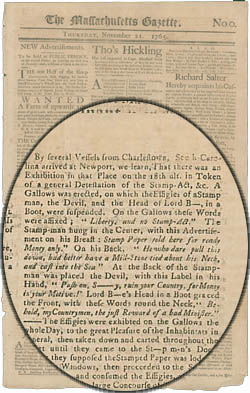"By several Vessels from Charlestown, South Carolina ..."
To order an image, navigate to the full
display and click "request this image"
on the blue toolbar.
-
Choose an alternate description of this item written for these projects:
- Main description
[ This description is from the project: Coming of the American Revolution ]
Enraged by the injustice of the Stamp Act, colonists held protests and demonstrations to show their opposition. One such protest in Charlestown, South Carolina is described here, including hanging effigies of colonists who were appointed stamp distributors as well as members of the British ministry.
"Liberty and no Stamp-Act"
News of the Stamp Act, which places a duty on items including newspapers, legal documents, licenses, and playing cards, reaches the American colonies in the spring of 1765. As legislators within each colony craft lofty petitions, other citizens plot an assortment of more dramatic activities to protest the unwanted tax. Adopting names including "Sons of Liberty," committees within each colony intend to prevent the Stamp Act from taking effect on 1 November 1765. Intimidation is their method of choice, and their primary targets are the colonists who have been appointed stamp distributors by the British ministry. While the protests occasionally turn violent, most demonstrations appear almost playful despite their menacing undertones.
To examine all six pages of this newspaper, please see the online display of The Massachusetts Gazette, 21 November 1765.
Questions to Consider
1. Briefly describe the protest in Charleston, South Carolina. What are the main activities that take place? Which government officials are being targeted by the protesters?
2. Who is the stamp distributor for South Carolina? What is his response?
Further Exploration
3. Compare this demonstration to the one that took place in Boston on 14 August 1765. (Click here to read an account of that demonstration.) How are the demonstrations different? How are they similar?
4. Diplomas are among the many items taxed as part of the Stamp Act. Imagine that you must now pay a tax in order to receive your high school diploma. Write a letter to your principal arguing against the diploma tax. (Click here to review documents related to the Stamp Act and colonists' reasons for protesting.)

